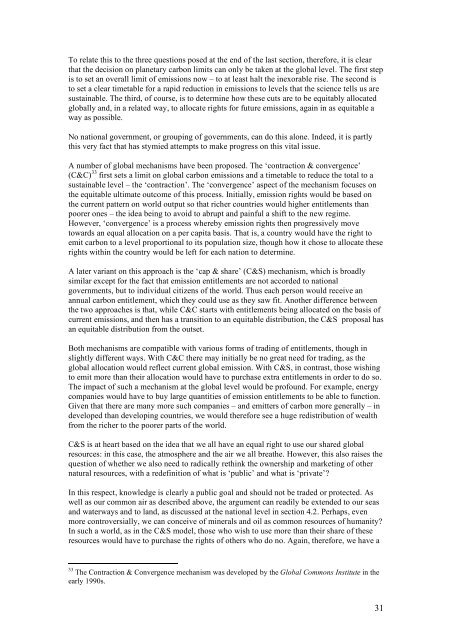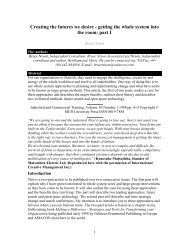From Old Economics to New Economics- Radical ... - Bruce Nixon
From Old Economics to New Economics- Radical ... - Bruce Nixon
From Old Economics to New Economics- Radical ... - Bruce Nixon
You also want an ePaper? Increase the reach of your titles
YUMPU automatically turns print PDFs into web optimized ePapers that Google loves.
To relate this <strong>to</strong> the three questions posed at the end of the last section, therefore, it is clear<br />
that the decision on planetary carbon limits can only be taken at the global level. The first step<br />
is <strong>to</strong> set an overall limit of emissions now – <strong>to</strong> at least halt the inexorable rise. The second is<br />
<strong>to</strong> set a clear timetable for a rapid reduction in emissions <strong>to</strong> levels that the science tells us are<br />
sustainable. The third, of course, is <strong>to</strong> determine how these cuts are <strong>to</strong> be equitably allocated<br />
globally and, in a related way, <strong>to</strong> allocate rights for future emissions, again in as equitable a<br />
way as possible.<br />
No national government, or grouping of governments, can do this alone. Indeed, it is partly<br />
this very fact that has stymied attempts <strong>to</strong> make progress on this vital issue.<br />
A number of global mechanisms have been proposed. The ‘contraction & convergence’<br />
(C&C) 33 first sets a limit on global carbon emissions and a timetable <strong>to</strong> reduce the <strong>to</strong>tal <strong>to</strong> a<br />
sustainable level – the ‘contraction’. The ‘convergence’ aspect of the mechanism focuses on<br />
the equitable ultimate outcome of this process. Initially, emission rights would be based on<br />
the current pattern on world output so that richer countries would higher entitlements than<br />
poorer ones – the idea being <strong>to</strong> avoid <strong>to</strong> abrupt and painful a shift <strong>to</strong> the new regime.<br />
However, ‘convergence’ is a process whereby emission rights then progressively move<br />
<strong>to</strong>wards an equal allocation on a per capita basis. That is, a country would have the right <strong>to</strong><br />
emit carbon <strong>to</strong> a level proportional <strong>to</strong> its population size, though how it chose <strong>to</strong> allocate these<br />
rights within the country would be left for each nation <strong>to</strong> determine.<br />
A later variant on this approach is the ‘cap & share’ (C&S) mechanism, which is broadly<br />
similar except for the fact that emission entitlements are not accorded <strong>to</strong> national<br />
governments, but <strong>to</strong> individual citizens of the world. Thus each person would receive an<br />
annual carbon entitlement, which they could use as they saw fit. Another difference between<br />
the two approaches is that, while C&C starts with entitlements being allocated on the basis of<br />
current emissions, and then has a transition <strong>to</strong> an equitable distribution, the C&S proposal has<br />
an equitable distribution from the outset.<br />
Both mechanisms are compatible with various forms of trading of entitlements, though in<br />
slightly different ways. With C&C there may initially be no great need for trading, as the<br />
global allocation would reflect current global emission. With C&S, in contrast, those wishing<br />
<strong>to</strong> emit more than their allocation would have <strong>to</strong> purchase extra entitlements in order <strong>to</strong> do so.<br />
The impact of such a mechanism at the global level would be profound. For example, energy<br />
companies would have <strong>to</strong> buy large quantities of emission entitlements <strong>to</strong> be able <strong>to</strong> function.<br />
Given that there are many more such companies – and emitters of carbon more generally – in<br />
developed than developing countries, we would therefore see a huge redistribution of wealth<br />
from the richer <strong>to</strong> the poorer parts of the world.<br />
C&S is at heart based on the idea that we all have an equal right <strong>to</strong> use our shared global<br />
resources: in this case, the atmosphere and the air we all breathe. However, this also raises the<br />
question of whether we also need <strong>to</strong> radically rethink the ownership and marketing of other<br />
natural resources, with a redefinition of what is ‘public’ and what is ‘private’<br />
In this respect, knowledge is clearly a public goal and should not be traded or protected. As<br />
well as our common air as described above, the argument can readily be extended <strong>to</strong> our seas<br />
and waterways and <strong>to</strong> land, as discussed at the national level in section 4.2. Perhaps, even<br />
more controversially, we can conceive of minerals and oil as common resources of humanity<br />
In such a world, as in the C&S model, those who wish <strong>to</strong> use more than their share of these<br />
resources would have <strong>to</strong> purchase the rights of others who do no. Again, therefore, we have a<br />
33 The Contraction & Convergence mechanism was developed by the Global Commons Institute in the<br />
early 1990s.<br />
31



